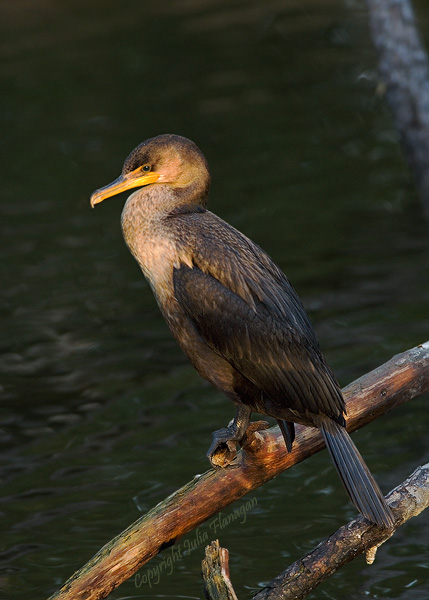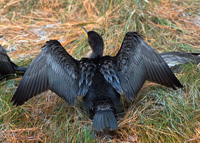
|
Double-crested Cormorant The snake-necked but stocky bodied double-crested cormorant is a common sight along Virginia’s shores and lakes where it is often seen on the bank standing, spreading and drying its wings before diving back into the water for more fish to eat. When in flight, the cormorant seems to skim the surface of the water, its elongated hooked bill angling upwards. Groups of cormorants usually fly in single file or in V-formation. When swimming, the bird sits low in the water with its neck and head showing; from there it plunges into the deep to catch fish at depths of up to 25 feet. It can also stay submerged for over a minute. For a change in diet, the cormorant will sometimes eat amphibians, insects, or the occasional snake. Cormorants build large, thick platform nests in trees but sometimes on the ground if in colonies. Their nests are made predominantly of sticks, but they are not discerning, using whatever they can find to provide a home for their young. When their eggs hatch after about a month, the adult cormorants will shade the chicks from the sun using their wings. As the young cormorants grow, they lose the pale chest and throat they were born with so that by the time they are adults they are usually nearly all completely dark feathered. Young cormorants also have yellow or orange beaks that also darken by adulthood, although the gular skin between the bill and throat remains orange. The cormorant is plentiful now and under no serious threat, even to the point where fishermen blame it, with little evidence, for depleting stocks. The bird was, however, almost wiped out by hunters in the nineteenth century and suffered more recently with the overuse of pesticides, mainly DDT, around its habitat. Keep reading... |
Home | Upcoming Events | About Us | Resource Issues | News | Local Contacts Maps | Photos | Publications | Youth Education | FAQ's | Links | Membership |






